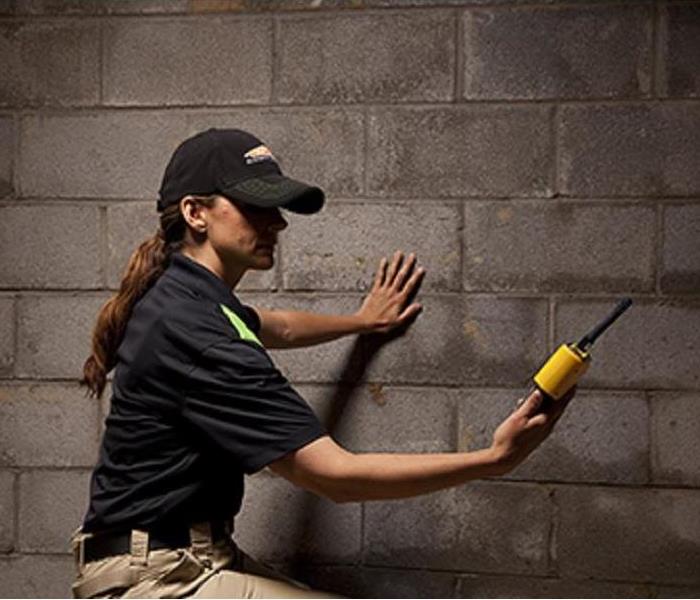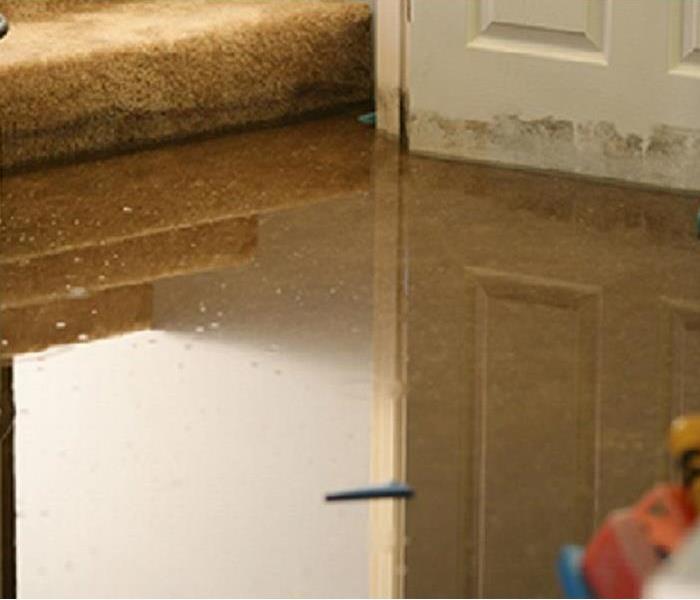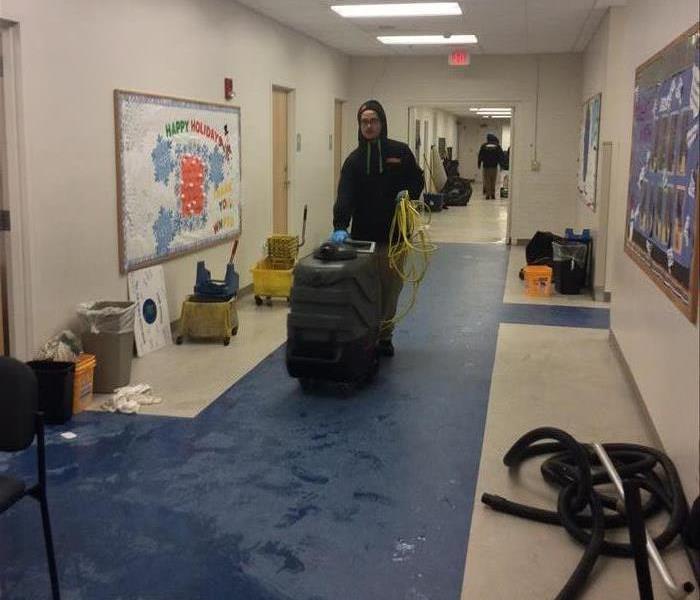Archived Water Damage Blog Posts
Beware at-home water damage remediation hacks!
6/8/2023 (Permalink)
Here in New England, we are fortunate to live in an area rich with history. Many historic landmarks are still standing to this day, some people reading this may even live in one of these incredible houses. It is no hidden secret that as buildings get older they require more upkeep and tend to be more susceptible to water damage and mold. These situations are not only devastating but can also be incredibly overwhelming to try and deal with on your own. The internet is full of at-home, do-it-yourself solutions, but there is a high likelihood that the homemade solutions offered up will only be a temporary fix, or may even make the situation worse! We have many trustworthy and factually accurate resources here on our blog, as well as trained professionals on call 24/7 ready to help you make it “Like it never even happened.”
The Mother of Floods
4/29/2022 (Permalink)
As we look ahead to May and Mother’s Day, your neighborhood SERVPRO team thinks it’s important to mark the Mother’s Day floods of 2006, which caused unprecedented damage to New Hampshire’s landscape and its communities.
Sure, they weren’t that long ago, but most people have probably already forgotten that 2006 brought historic flooding to NH, which led to an official disaster declaration by former president of the United States, George W. Bush.
While no one, fortunately, perished in these floods, water damage across the state of New Hampshire exceeded $14 million, with an estimated 600 roads closed and approximately 60 washed away.
With these statistics, it’s easy to assume that people just didn’t do enough at the time to mitigate the disaster.
However, Goffstown fire Lieutenant Bill Connor recalls, “It started as a typically rainy weekend. We started getting calls that were giving us a hint that something bigger was happening.”
As we now know, something bigger did happen, of course; however, for the Goffstown Fire Department, the floods came with a small, but significant silver lining: “We now have boats with engines that are made to operate in different conditions than the ones we used to have. We’ve changed our suits that we use for rescue,” according to Connor.
Sometimes it takes a mother of a flood to shine the light on the need for stronger emergency forces, in the event that our state should ever experience another flood of this magnitude again.
Should you find yourself dealing with water damage on your property, your local SERVPRO of Haverhill / Newburyport team will show up to save the day, delivering water restoration and water remediation services you can trust.
What is a Water Table and Why Should Homeowners Care?
3/29/2022 (Permalink)
Do you know what a water table is or, more importantly, why it matters when it comes to your home? A water table, or groundwater table, represents the surface underground that is permanently saturated with water, which can fluctuate between seasons and over time, depending on climate shifts. In other words, it’s the boundary between the wet and dry zones underground.
Why does this matter to homeowners?
The water table can potentially compromise the foundation of your home, depending on other factors like soil conditions and effective drainage around your home.
Too much water absorbed into the soil from a high water table can result in the ground around your home becoming too saturated, resulting in swelling. This puts undue pressure on your foundation, which can lead to water leaking through the bottom, even if it’s made of concrete.
Perhaps more likely than a foundation issue, the presence of too much groundwater can cause humidity-related problems, like the growth of mold and bacteria.
Fortunately, water damage restoration and water damage remediation is our area of expertise. If you’re concerned about water damage related to your water table or any other cause, reach out to your local SERVPRO of Haverhill / Newburyport team.
Knock, Knock. Are You Letting in Leaks?
2/25/2022 (Permalink)
Smart homeowners make every effort to ensure their doors and windows are locked to keep out any unwanted or uninvited guests. The trouble is, when it comes to water damage in your home, there are plenty of places for it to hide.
Water damage doesn’t always look as dramatic as, say, basement flooding, but it can be just as destructive when it goes undiscovered for any length of time.
For instance, a top hiding spot where water collects and causes damage is just outside your front door. Or even your back door. Really, any exterior door threshold has the potential to suffer water damage, especially after significant or sustained rainfall.
Over time, you might start to see the metal threshold loosen because the wood beneath is rotting or has, in fact, rotted away.
Keeping an eye on telltale signs of water damage like this is important when it comes to protecting the structural integrity of your home. Also important? Knowing who to call for water damage restoration and water damage remediation.
Contact your local SERVPRO of Haverhill / Newburyport team at the first sign of water damage for professional restoration services designed to protect your home.
Snow’s Melting -- Yay! Basement’s Flooding -- Oh no!
1/31/2022 (Permalink)
Whether you’re returning home from a fantastic getaway or just an afternoon spent running errands, discovering your basement flooding will certainly take the wind out of your sails.
As we New Englanders know, the weather patterns around here change on a dime and an Arctic freeze one week can turn to mild temperatures the next. When this happens, especially if the rising temps are accompanied by rain, whatever snow is on the ground tends to melt too quickly.
The result? Flooded basements, frustration, and the need for water damage restoration ASAP.
Fortunately, our SERVPRO team has a few snow-savvy tips to help you avoid this situation and the need for water damage remediation.
Protect Your Basement from Melting Snow
It’s always a good idea to keep an eye on the weather forecast, even after our area has experienced significant snow accumulation. If the prediction includes a warming trend or rain, you’ll want to make time for some strategic snow removal, to avoid the need for professional water removal.
- Start by pulling down snow from the roof with a roof rake.
- Shovel any snow that’s fallen from the roof, along with snow that has accumulated on the ground, well away from the foundation of your home. Ensure a good five-foot buffer between the snow pile and your home’s structure.
Of course, you’ll want to check the condition of your basement, too. Take a walk around and identify any cracks where water could leak in from the outside.
Sometimes even our best efforts fall flat and we’re left dealing with a basement flood, anyway. In this case, contact your SERVPRO of Haverhill / Newburyport team for fast and reliable water removal.
Ice: Good for Skating, Bad for Pipes
12/30/2021 (Permalink)
As the winter gets colder, there are more fun activities to do outside, which makes the season more exciting. Unfortunately, this also means an increase in elements to protect your house from in order to avoid needing professional residential cleanup or restoration services. What’s a common denominator between the two? Ice.
Great for skating and fun to sculpt, you don’t want ice coming in contact with your home’s pipes. SERVPRO of Haverhill knows how to ensure the water stays flowing, so you can focus on the winter wonderland fun to be had outside.
Keep The Water Flowing!
We do not want your pipes to freeze -- and neither do you. Frozen pipes can result in exploding pipes and ultimately, water damage throughout your home. How can this be avoided?
Here is what you need to know!
- Keep that garage door closed! This is the best way to protect your house’s water tank if it is kept in the garage or down below in the basement.
- Keep interior doors open! Heat will flow more easily throughout the house if doorways are kept open.
- Speaking of heat, keep it on! Keeping the house warm ultimately keeps the pipes warm.
- Let faucets drip! If it is dripping, water is able to continue to move through your pipes, preventing any potential backup or freezing.
This winter, get out there to ski, sled, and skate whenever the opportunity presents itself! Just be sure to put these helpful hints into practice in order to keep any of that ice out of your pipes.
When temperatures start to freeze, turn to the experts to keep your home’s water flowing. Your neighborhood SERVPRO team is always ready and prepared to help with any emergency service or potential water restoration needs! Contact SERVPRO Haverhill / Newburyport, 24/7!
Save Your Plumbing this Thanksgiving
11/21/2021 (Permalink)
As you probably know, the busiest day for travel is the Wednesday before Thanksgiving. That being said, can you guess what day is the busiest day for plumbers? Bingo! The Friday after Thanksgiving is the most common day for a plumbing problem. SERVPRO Haverhill / Newburyport is here to help you with all of your holiday maintenance questions.
There are common problems that arise post the big feast. Some of them are clogged sinks, no hot water, and, of course, backed-up toilets. If you are hosting this year make sure to stay alert for these common problems.
Sink Situation
Your biggest enemy on Thanksgiving Day while you’re doing the dishes is “FOG.” This acronym stands for Fat, Oil, and Grease. These are common components in most traditional Thanksgiving foods. Whenever you start cleaning that mountain of dishes, all that gunk will start sliding down your drain and potentially clogging it. Find another spot for all this “FOG!”
No-go on Hot Water
As more guests come into your home, more hot water will be used. Your hot water tank grows for no one! Because of this, you are more likely to run out of hot water. The way to fix this is to encourage shorter shower times. It could be seen as an inconvenience but it’s a far better alternative to a cold shower!
Toilet Troubles
No doubt, you get the gist here: overuse and too much toilet paper. If your toilet is being used more often, the flushing will be near constant. This could lead to flooding and a need for water restoration. Make sure to stay ahead of this by using less toilet paper and keeping a plunger handy!
As always, SERVPRO is here to answer any of your questions and we hope you keep us in mind for water damage and water restoration service if any of these problems get out of hand!
The 411 on What to Include in Your Flood Kit
10/21/2021 (Permalink)
For the past 25 years, America has experienced a flood in urban areas every 2-3 days. Before the call is made for water removal, you must first get through the flood-causing natural disaster safely. The best way to do this is to stay alert, keep an eye on the weather, and have your flood kit on hand and ready to go.
Flood kit? What’s a flood kit and what should be in it? These are the questions to ask now, before the flood or any other potentially damaging weather event.
What is a Flood Kit?
This pack is a grab-and-go tool that will be able to help you survive if you get displaced from your home. Typically, these kits feature a 5-year shelf life, along with everything you might need to keep your family safe when disaster strikes.
What Do I Put in My Flood Kit?
When facing the possibility of serious water damage in your home or business, it is difficult to remember that this pack is for essentials only.
Here is a quick list to help you build your flood kit:
- Water! The first thing that every flood kit needs. The rule of thumb should be 1 gallon per person, per day.
- Non-perishable food. Pack a supply that will last for 3 days.
- Flashlight and extra batteries.
- First aid and hygiene kit.
- Cell phones, chargers, and extra batteries.
- A map of your local area.
Keep your flood kit handy and your family safe in times of crisis resulting from storm damage. Always remember to call us, SERVPRO of Haverhill/Newburyport, so that our team can help you navigate the aftermath of the flood.
Keep Your Artwork Safe from Water Damage
9/27/2021 (Permalink)
 Pictured above is Vasari's The Last Supper, not to be confused with Da Vinci's painting of the same name. Photo via The Florentine.
Pictured above is Vasari's The Last Supper, not to be confused with Da Vinci's painting of the same name. Photo via The Florentine.
Whether it’s something you created or a beloved heirloom passed down from one generation to the next, artwork enhances our homes, which is why it’s important to protect it. Water damage is a leading cause of damage on art pieces, especially canvas paintings. If the water sits long enough to turn into mold, the damage done is typically irreparable.
Except in one famous case involving one very famous work of art…
Another Look at The Last Supper
Following the worst flood Florence, Italy has ever experienced, Giorgio Vasari’s masterpiece, The Last Supper, completed in 1546, was considered destroyed. The flood waters, which had been accumulating throughout October and November of 1966, burst into Florence, dumping water and sewage across 7,000 acres of the city, including 600,000 tons of mud and other detritus.
According to the Getty Foundation’s Antoine Wilmering, “During the flood, The Last Supper was submerged in a slurry of water, mud, and heating oil for over twelve hours, which softened the paint and saturated the wooden support structure. When the sludge receded, some of the paint and gesso migrated with it toward the bottom of the painting.”
Rather than consider it a lost cause, a team of specially trained art conservation professionals spent a decade restoring the painting to its original glory, returning it to the Museum of the Opera of Santa Croce in Florence in 2016, 50 years after the flood did its damage.
Save yourself the headache of an art restoration undertaking by following these steps to store your artwork properly, keeping it safe and sound from the elements, pests, and everything in between.
- Store canvas paintings away from sunlight, which can cause fading over time.
- Cool and dry is key; make sure the storage space is climate controlled, if possible, to protect the canvas against mold and mildew.
- Keep your artwork away from the floor, not only to avoid a major water damage incident, like a flood, but because moisture can leak in and cause the canvas to warp.
- Mirror boxes make excellent storage spaces, but ensure that they are stored high off the ground.
If you experience water damage in your home, contact your team of water repair and restoration experts at SERVPRO of Haverhill.
Does Water Damage ________?
9/3/2021 (Permalink)
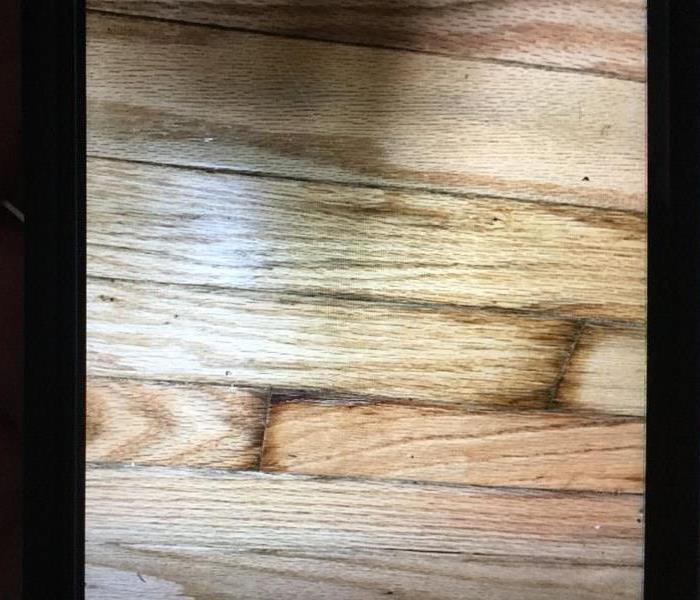 An example of how water can damage hardwood flooring.
An example of how water can damage hardwood flooring.
Some of the most common questions we get asked is if water will damage this, that, or the other thing. To help answer your questions once and for all, we’re calling in an expert; our very own Key Accounts Manager Nury Cardoza! As a former production technician, crew chief, and estimator, Nury has over 20 years of real-world industry knowledge, including how water damages various materials. Here’s a summary of what she had to say:
Can water damage concrete?
Not really. If the water is running constantly over it, it can start to erode but it won’t get damaged just from a flood.
Will water damage leather?
Yes! Mold will also grow really fast on leather because it is a good source of food, and the mold will eat it.
Does water damage suede?
Yes, similar to leather, suede (and many other fabrics) is a great source of food for mold, which means the mold will spread rather quickly on suede surfaces.
Will water damage hardwood floors?
Oh yes! The wood will suck up the water, causing it to swell and buckle. I remember a job where a woman was on vacation in Florida, and something burst while she was away. When she got home, she couldn’t even open her door because her [beautiful hardwood] floors had buckled so badly.
Can water damage laminate flooring?
Yes, water can get trapped between the laminate and whatever is underneath it, and the water won’t dry which can cause mold.
Will water damage plywood?
Yes. If plywood is exposed to water frequently or for long periods of time it can begin to swell and warp. It is also another big source of mold.
How to Reduce Mold
7/17/2021 (Permalink)
Have you ever seen dark brown or black spots in between the grout of your bathroom tiles or on your bathroom ceiling? That’s not just hard water residue. Instead, in those spots, it’s most likely to be moisture that has gone past mildew levels (typically gray colored) and become mold.
Want to get rid of it? If you’re thinking about grabbing some bleach and scrubbing it away, take a moment. Yes, that’s what you’ve heard to do, but the US Environmental Protection Agency (EPA) actually recommends against homeowners themselves trying to remove mold with bleach.
You can certainly try to handle the mold with white vinegar, but do you have a N95-level respirator mask (not to be confused with the cloth masks people wear during the pandemic), goggles, gloves, and a throw-away outfit? Probably not, which is just one reason why you should leave the job to Massachusetts mold remediation experts like SERVPRO of Haverhill / Newburyport.
Another reason to do so? Even if you use white vinegar or bleach, you still might just be removing the mold at a surface level and not fixing the root cause, which will cause the mold to come back.
Once you’ve had the mold removed, you can then work on reducing it from recurring. Here’s some ways to do so:
- Install a bathroom vent to reduce moisture
- If you can’t install a vent, open the window or door after every shower
- Wipe down your bathroom walls and ceiling after the room is damp
Here at SERVPRO of Haverhill / Newburyport, we are professionally trained in mold removal and can assess your mold damage both safely and effectively with devices that can weed out and remediate hidden mold sources. After the assessment, we will move on to mold containment, air filtration, cleaning and sanitizing, and then mold restoration, which could involve replacing drywall if the mold damage has gone that far.
Contact us for your mold damage assessment at your first signs of mold to prevent a larger-scale mold clean up.
Choose the Best Water Damage Restoration Company for Your Budget
6/10/2021 (Permalink)
Unless you live in a known flood zone, or know that your roof should have been replaced about a decade ago, you probably don’t have water damage restoration in your budget for this year. Or any year. Unfortunately, floods, leaks, and other water disasters happen, causing you to need to find the money for a water damage restoration company to repair your home.
You might also have hidden water damage in your home. Learn how to spot this damage before it becomes a bigger, more expensive, problem.
How can you find the best Massachusetts water damage restoration company for your budget?
- Insurance. We work with most insurance companies, and probably work with yours. For a stress-free claims process for your water damage, we can help you manage your insurance paperwork and the process.
- Reviews and recommendations. Talk to your local neighbors and friends and see who they’ve worked with to handle emergency situations. Or go online and look at our Testimonials.
- One company for all. Work with a company that can handle your water damage remediation as well as any rebuilding services that you need. Our professional team at SERVPRO of Haverhill / Newburyport can simplify your water damage restoration process by helping you with both the remediation and restoration and the rebuild. Using one expert company for all of your water damage restoration needs alleviates your stress of having to find a contractor on top of everything else, saves you time, and keeps your costs low.
These are just some of the rebuilding and restoration services that our construction division offers to restore your home to its original state:
- Drywall removal and installation
- Hardwood floor repair
- Tile floor repair
- Painting
- Carpet repair and installation
Contact us here at SERVPRO of Haverhill / Newburyport for an assessment of your water damage in Massachusetts along with a plan for remediation and rebuilding to bring your home back to its pre-water damage state.
How to Detect Water Damage in Your Home
5/14/2021 (Permalink)
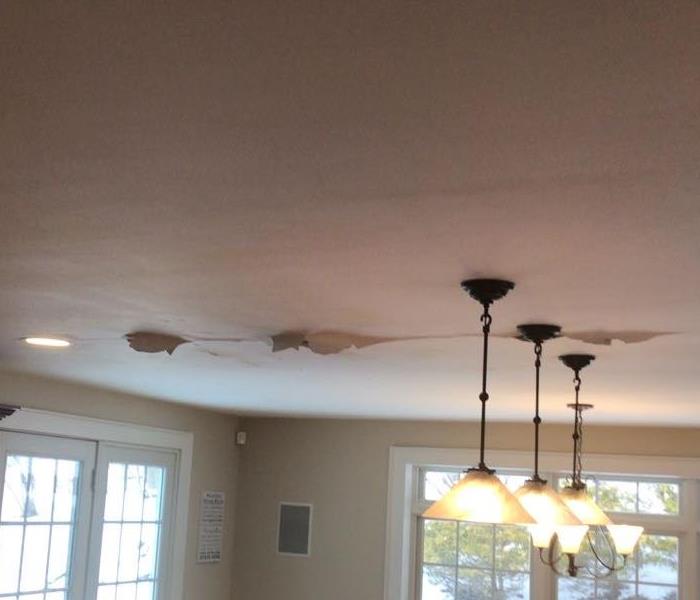 When these homeowners noticed paint on their kitchen ceiling was starting to bubble from water damage, they knew it was time to call the experts!
When these homeowners noticed paint on their kitchen ceiling was starting to bubble from water damage, they knew it was time to call the experts!
There are two types of water damage that could be in your home: visible water damage, which the type you can blatantly see in the form of water leaking from the ceiling or puddles from a flood, and hidden water damage that is lurking behind your walls, in your rugs, or inside your ceiling.
The first type of water damage is easy to spot, but the second is more insidious. Even though you can’t see hidden water damage right in front of you, there are ways you can tell if there might be water damage in your home that needs to be addressed.
- A new musty scent. If your closet, basement, or one of your rooms starts smelling musty, there may be hidden water damage that resulted in mildew or mold.
- Bubbles in the paint of your ceiling. Yes, these could be just from steam in your bathroom forming a coat of moisture, especially if they’re on top of your shower, but they could also be caused by water that collected in your ceiling and is popping through the ceiling as a bubble. This is particularly bad if it’s not a pin-sized dot of a bubble and is instead the size of a dinner plate or larger. That water damage should be remediated immediately.
- Peeling or stained paint on your wall. This is the same as bubbles on the ceiling, except that in this case, the paint could be flaking off or stained from water that has collected in between your drywall and the layers of paint.
- An increase in your water bill. Stay on top of what you pay each month. If it has suddenly increased without any uptick in water usage, you could have a hidden water leak.
Think there’s hidden water damage in your home and you want to be sure? Reach out to the Massachusetts water damage remediation experts at SERVPRO of Haverhill / Newburyport. We have state of the art technology to assess and spot the water damage you can’t see and to restore your home to its pre-water damage state.
How to Dry Out after Basement Floods
4/17/2021 (Permalink)
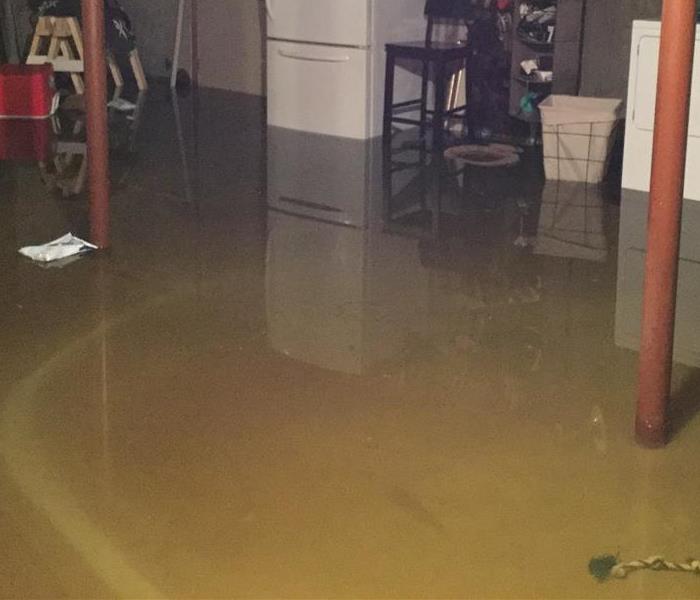 If you find yourself in some deep water, give us a call. We're here to help anytime, 24/7/365.
If you find yourself in some deep water, give us a call. We're here to help anytime, 24/7/365.
Did you find your way here by searching for “what to do after a basement flood”? If so, first we’re sorry this happened to your home. Know that you’re not alone, as many homeowners have dealt with the same thing.
Basements can flood for any number of reasons: living by a lake or in a known Massachusetts flood zone; a heavy rainstorm that seeps in through a fieldstone foundation or a crack in your basement window, wall, or door; or a burst hot water heater.
We’re going to assume that you’ve already turned the power off to your basement and have taken care of that, since that’s important to avoid an electrical shock. Haven’t done that yet? You can turn it off yourself if your circuit breaker is accessible from upstairs. If it’s in the basement, call an electrician or the electric company to shut the power off at your home before you venture into the basement to remove the water.
If you live in a known flood zone, you may have a sump pump that works to remove the water when the electricity is on. If you don’t have a sump pump, or your sump pump isn’t working, which caused your basement to flood, you can use a wet/dry vacuum to remove a small amount of water.
Have an inch or more of water? Contact your Massachusetts emergency water removal service like SERVPRO of Haverhill / Newburyport. We will get the water out and then start the process of drying out your basement with our professional dehumidifiers and fans.
Want to try drying out your basement yourself? Here’s how:
- Remove all the water
- Open your basement windows and doors
- Take all items out of your basement and make sure they’re dried separately and thoroughly, and also cleaned to prevent mildew or mold
- Set up fans and dehumidifiers to speed up the dryness
If you had a flood in your basement and need help, check the steps of our water damage restoration process. Contact us here at SERVPRO of Haverhill / Newburyport for an assessment of your water damage in Massachusetts caused by flooding along with a plan for remediation and clean up.
Broken Water Main: What’s Next?
3/17/2021 (Permalink)
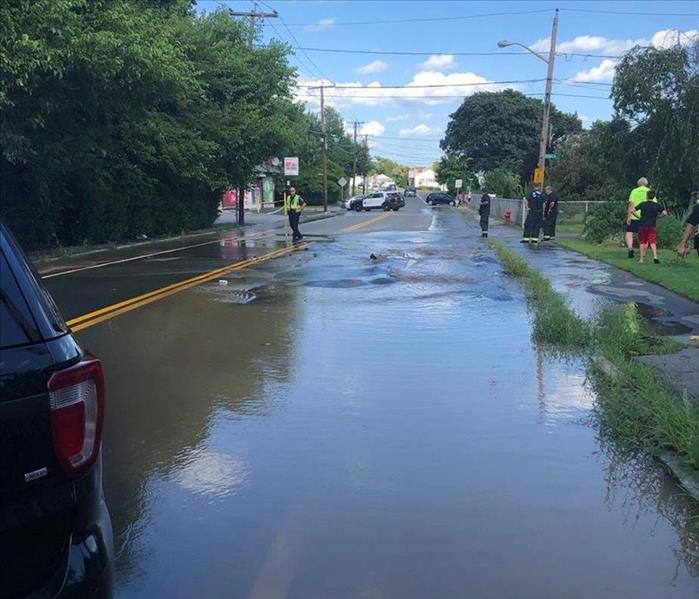 This street in Methuen flooded back in 2019 as a result of a broken water main.
This street in Methuen flooded back in 2019 as a result of a broken water main.
As a homeowner, you’re used to having access to clean water when you want to take a drink, brush your teeth, boil water to cook, or use the bathroom. There may be times when you turn on the water tap to find that the water is brown or doesn’t turn on at all. In those cases, though, it’s more than likely that the town is flushing the main water pipes in your area, and they’ll be back to clear water in less than a day.
However, there is another reason why your water might be brown: a broken water main. If a water main breaks, that results in a change in water pressure in the pipes, causing sediment and rust that’s inside city or town water lines to flow through.
What does a water main break mean? That term describes when a water line breaks that delivers water underground to homes. The signs of a water main break include brown water, low pressure (remember that “Seinfeld” episode about the low pressure shower head?), or water or sewage seeping into your basement or lower level of your home. That’s just inside your home.
Other signs that a water main has broken can include water bubbling up from the street, water flowing down streets or yards without an obvious source (like someone hosing down their car), and a sinkhole.
Once the water main break has been fixed, you still have tasks to complete:
- Turn on your cold water faucets and let them run for two minutes after they turn clear
- Turn on your hot water faucets and wait until the water gets hot
- Turn off the hot water and then after an hour or two, turn them back on to fully flush the hot water lines
- Run your washing machine (and dishwasher if you have one) twice without anything in it, including any detergent, and then a third time with detergent
- Look for any water damage in your basement as a result of the water seeping in
If the damage to your home requires the help of an expert, contact our Massachusetts water damage team here at SERVPRO of Haverhill / Newburyport. We can perform an assessment of your water damage along with a plan for water damage remediation.
Moisture in Closet: Top Cleanup Tips
3/3/2021 (Permalink)
When you think of your closet, your thoughts probably turn to wanting more space or wondering if you need to hang some mothballs in a storage closet. But did you know that moisture can be a problem in your closet? This is especially true if your closet is on an outside wall and there isn’t much, if any, insulation above or below it.
The first sign of a moisture issue in your closet could be droplets of water that show up on the ceiling, or clothes at the top of your closet that feel damp, if clothes are stacked to the ceiling on a shelf. What can you do to lessen the moisture in your closet and prevent it from becoming water damage or mold?
You have a few options:
- Purchase DampRid or another desiccant that will hang in your closet and take in moisture
- Instead of DampRid, you can also place a bowl of baking soda on the floor or a shelf in the closet that will take in moisture
- Get a mini dehumidifier to place in your closet, typically up where the moisture has been seen
- Remove everything from the closet and spray clean the closet with hydrogen peroxide and vinegar, or use a bleach disinfecting wipe to clean off the walls/ceiling
- Leave the closet door open more often to let air circulate
- Along with the closet door, open your windows in the room during the day if possible for further air circulation
- Check the clothes in your closet to make sure you haven’t accidentally put any damp clothes in the closet
- Add further insulation to the room above and below the closet
Have you not noticed the moisture until it became a mold issue? Contact us here at SERVPRO of Haverhill / Newburyport for an assessment of your mold damage along with a plan for mold remediation.
Insurance and Water Damages
2/5/2021 (Permalink)
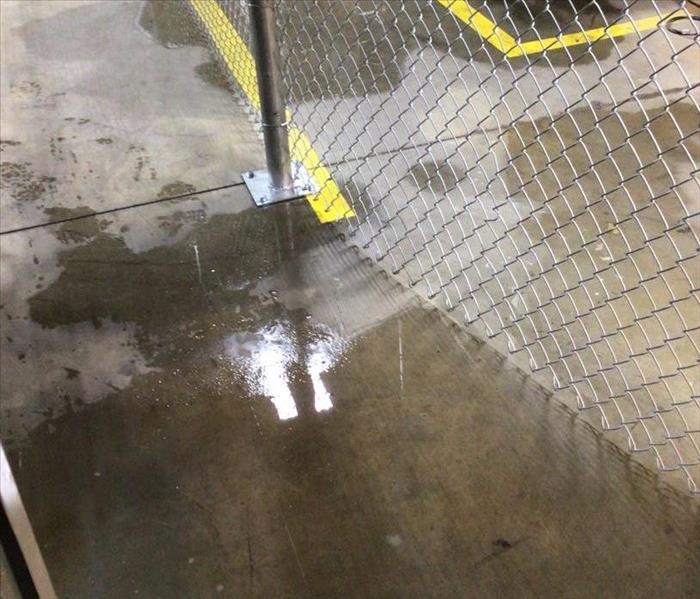 An example of a flooded basement.
An example of a flooded basement.
In her first blog post, Key Account Manager Nury Cardoza shares some insights about water damages:
Did you know you are more likely to experience floodwater damage than fire damage during your 30-year mortgage? For that and other good reasons, it makes sense to ask for flood insurance. One in every four insurance claims during the last two years was the result of water damage, and not every kind of water damage is covered by insurance.
Examples of water damage usually covered by insurance are:
- ice dams
- leaking roof
- frozen burst pipes
- accidental plumbing or appliance issues
- vandalism.
Water damage not usually covered by home insurance:
- groundwater getting into the basement
- floodwater or rapid- thaw water getting into the basement unless you have flood insurance
- sewer or water pipes back up unless you have a cover added to your home insurance policy
- leaks from corroded pipes
- leaks from an unmaintained roof
- damage from long term leaky faucets or toilets
- mold or fungus unless it resulted from covered causes
Remember that getting a qualified water damage cleanup and restoration company is as essential as obtaining the right insurance coverage. SERVPRO works with many insurance companies, which makes the whole process less stressful and faster for you. Day or night, 365 days a year, we are here to help.
Avoid a flooded basement, this year and forever!
1/22/2021 (Permalink)
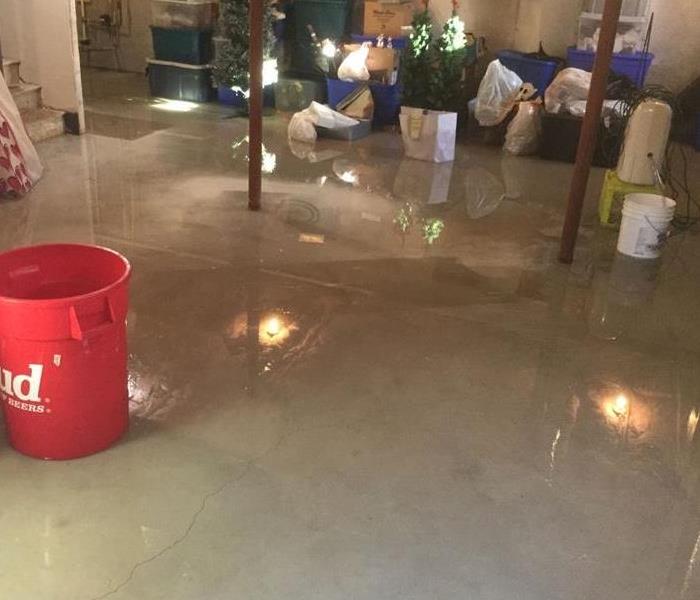 An example of a flooded basement.
An example of a flooded basement.
Weather in Massachusetts is unpredictable, so even if you don’t have a lot of snow now, you never know what Mother Nature has in store for the rest of the season.
In late winter and early spring, the ground can’t absorb all of the rain and snow melt, so it flows along the foundation. Foundation cracks that weren’t a problem before have the potential to become a huge problem now. A proper drain system, sump pump and sealed cracks will help you avoid problems this spring.
Here are a few simple tips:
- Keep your gutters clean (this will keep rainwater from flowing directly to your foundation)
- Grade landscaping away from foundation (add mulch or soil at an angle, higher at the foundation, slanting away)
- Check your sump pump or purchase a submersible pump and fans.
Move valuables and expensive items you may have in your basement or use pallets and shelves to keep them elevated.
When there is a natural disaster, often the emergency items you need are sold out, so plan ahead.
If you do have a flood
There are still things you can do to mitigate the damage.
- If you can do it safely, turn off the electricity.
But don’t get electrocuted! If you can reach the breaker without standing in water turn it off.
- If you’ve got just a bit of water in spots consider yourself lucky. If you can clean it up with a wet vac and have fans to dry it afterward you might be all set.
- If your basement has flooded more than an inch, it’s best to call us.
If you have a sump pump and fans, you may still wish to tackle the job by yourself. Submersible water pumps work best when you place them in the deepest part of the flooded water. If dirt and debris build up and clogs the screen around the pump, clean it out and consider using something like a small tool to prop it up a bit. This will increase the space for water to flow through the pump. Use the widest and shortest hose possible, this will enable the pump to work faster.
When all the water is up, and it appears dry you may still want us simply to treat the previously flooded area to kill any mold before it’s an issue.
To avoid this problem next year, you must identify where the water came in.
- First, seal the cracks.
- Then, dig to avert water flow next time.
Remember water will travel down the path of least resistance. It is strongly advised to dig outside near the foundation and repack the soil. Dig down to where the water came, and then dig out and to the sides a few feet. There is a channel that you may not see but you will disturb and avert if you do this. Next year, water will not flow in that same direction if done correctly.
Last but not least, having a dehumidifier in any basement, old or new, is a must to help reduce the amount of excess moisture in the air.
Recap:
- Clean your gutters.
- Have a sump pump, wet vac and fans.
- Fix lawn grading.
- Seal the cracks.
- Dig to avert water flow next year.
- Have a dehumidifier.
If water comes in and it’s too much to tackle yourself, call us. Mitigating water damage is one of our core competencies. We’ll tackle the job at hand and be sure your water problem doesn’t become a mold problem later.
Hidden Water Damage
9/10/2020 (Permalink)
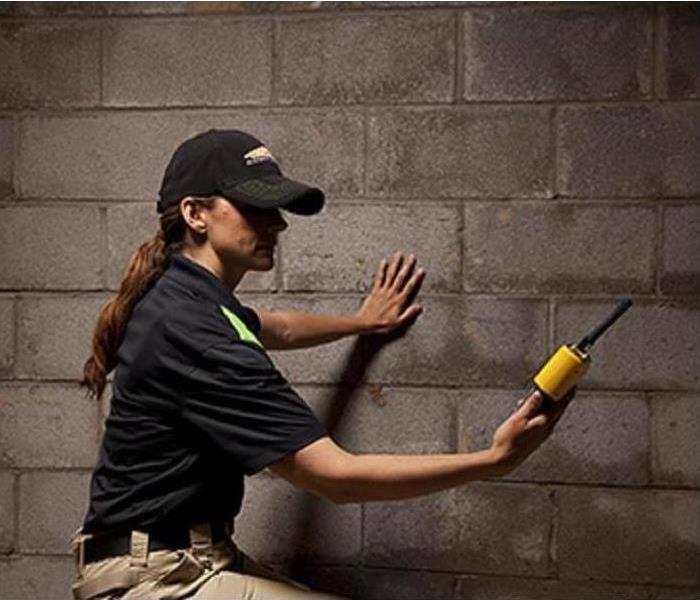 An example of a Moisture Meter in action.
An example of a Moisture Meter in action.
Even Minor Water Damages Need Major Technology –
Small water damages can sometimes lead to big problems if it’s not handled properly at the onset. The key to avoiding costly restoration is to treat even the smallest of water problems as a real threat to your property. This means adequate technology & equipment should be a priority when mitigating any loss.
Some of these tools are not readily available, or easy to use. SERVPRO of Haverhill/Newburyport has the equipment, training and experience to find and dry hidden water before secondary damages occur.
Here are a few of the tools we use:
- Moisture Sensors are used to detect moisture in carpets and baseboards.
- Moisture Meters (pictured) are used to determine the actual moisture content of various materials. These moisture testers provide accurate readings that allows our trained professionals to monitor the drying process.
- Thermohygrometers measure temperature and relative humidity. When armed with this information, our team can calculate and create an environment most conducive to drying your space.
Contaminated Water
9/10/2020 (Permalink)
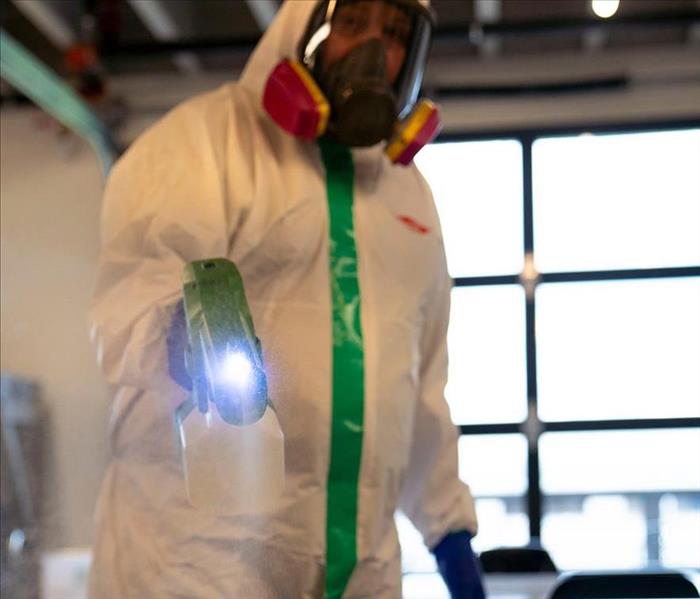 Thermal Fogger in action.
Thermal Fogger in action.
Love that Dirty Water…only in the Song!
When facing a contaminated water loss, it’s important to understand that disinfecting is just as important as drying. There are different levels of contamination, with the highest being a Category Three (or Black Water). According to owner, Pat Lavigne, this level of contamination could be considered a Biohazard and requires a more intensive process.
If you have a contaminated water damage, it’s imperative to pull in a professional remediation company such as SERVPRO of Haverhill/Newburyport. In addition to professional training and hospital grade disinfectants, we can also use state-of-the-art technology that is not readily available to the general public.
Two of the tools we use are:
- Ultra-Low-Volume (ULV) Foggers will atomize liquid deodorizing agents, producing a fine mist that can easily penetrate the site where odor-causing residues may accumulate. This device can also be used to inject fungicides and disinfectants into wall cavities and other hard-to-reach places.
- Thermal Foggers (pictured) use heat to vaporize a fogging solution. The fog consists of tiny particles of deodorant solution that attach to and neutralize odor causing molecules. Thermal foggers can produce very tiny particles, which range from 0.5 micron to 50 microns, so it is able to permeate even the narrowest of crevices.
If you have a water damage you believe to be contaminated, call in the professionals. We are open 24/7, so if you ever find yourself in hot (or dirty) water, we’ll be there, ready to help make it “Like it never even happened.”
Estimator Tips
9/4/2020 (Permalink)
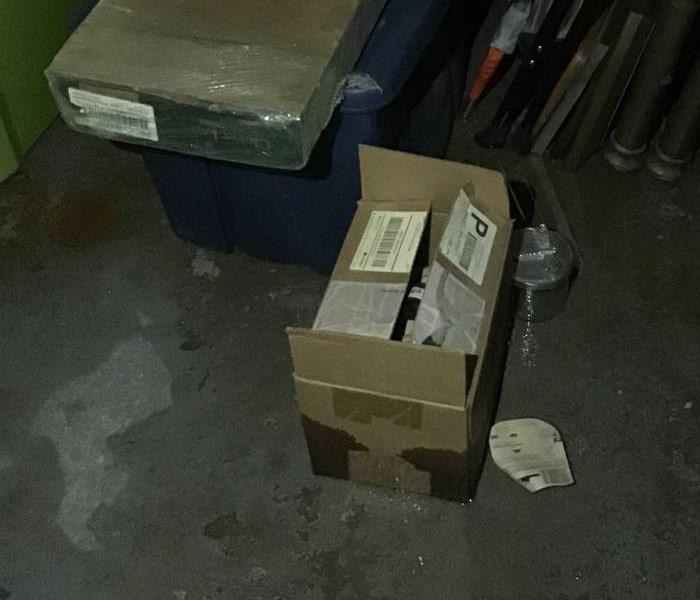 Example of personal items affected by water damage in a basement.
Example of personal items affected by water damage in a basement.
Storm season in New England is in full swing. Although these storms can move out as swiftly as they move in, we often experience such heavy rains that the ground simply cannot absorb it all quickly enough. When that happens, the water will find the downward path of least resistance, which can often be your basement.
We asked two of our Project Estimators, Brian Carifio and Ross Martin, about their best advice for homeowners after heavy rainstorms. Here is what they had to say:
- What’s the first place you would advise a homeowner to check after a storm?
Brian Carifio: The Basement. Water will find its way there. Ideally, if they’ve been pre-emptive, they’ll have their contents up off of the floor on plastic shelving and/or in plastic containers. Keeping contents 2–4 inches off the floor will help to avoid most flooding concerns. If the water reaches above that, they have a whole other set of problems. Plus, content damage is not generally covered by insurance when due to flash flooding.
- Okay, they’ve done that but they still have water in the basement. What should they do next?
Brian Carifio: Call SERVPRO. Not to sound self-serving but the longer the homeowner waits…or tries to resolve it themselves, the greater the probability of mold beginning to grow. Most DIY attempts at mitigating water damage fail simply because the necessary equipment is not available to consumers. You need strong extraction systems, high capacity dehumidifiers, and air movers (not to be confused with oscillating fans).
- What’s the worst thing a homeowner can do when they find water in their basement?
Ross Martin: Put an oscillating fan on the standing water. First of all, you can run the risk of electrocution. Beyond that, fans only whisk the air off the top of the water’s surface and move it into the air. Doing that without proper dehumidification in place can lead to mold on other surfaces.
- Can you explain that process more?
Ross Martin: Sure. When you have a flood, if left alone the water will eventually evaporate. But that doesn’t mean it disappears. It simply changes from a liquid to a gas and moves into the air. Moisture in the air is relative humidity. That humid (moisture heavy) air is then able to touch & attach to every single surface in that space and beyond. This is the “perfect storm” for mold growth.
Our process is to first extract the water with truck mounted vacuums, then use our air movers and dehumidifiers simultaneously. The movers circulate the air, keeping it from absorbing into surfaces while the dehumidifiers remove the moisture from the air.
- Can’t homeowners do this themselves?
Ross Martin: Yes and no. There are several points to consider. First, consider the weight of water (not the movie!). A gallon of water weighs 8.34 lbs and most shop vacs hold 10 gallons. That means you’re carrying 83.4 pounds upstairs, multiple times.
Secondly, most people have fans in their home and will put several on the affected wet areas, thinking this will dry it out. It won’t. Fans are not strong enough and they don’t actually dry anything. They just move the moisture off the top surface, dispersing it throughout the air.
Lastly, most consumer-bought dehumidifiers are too small to effectively dry the air in an average sized basement. Most are purchased rated at 30 PPD (Pints Per Day). That’s how many pints of moisture it can handle per day. Our smallest is 70 PPD and goes up to over 133 PPD.
There are some steps you can take before help arrives though.
- Remove excess water by mopping and blotting.
- Wipe excess water from wood furniture after removal of lamps and tabletop items.
- Remove and prop wet upholstery and cushions.
- Place aluminum foil or wood blocks between furniture legs and wet carpeting.
- Turn air conditioning on for maximum drying in summer.
- Remove colored rugs from wet carpeting.
- Remove art objects to a safe, dry place.
- Gather loose items from floors.
Prepare for Hurricane Water Damage
9/2/2020 (Permalink)
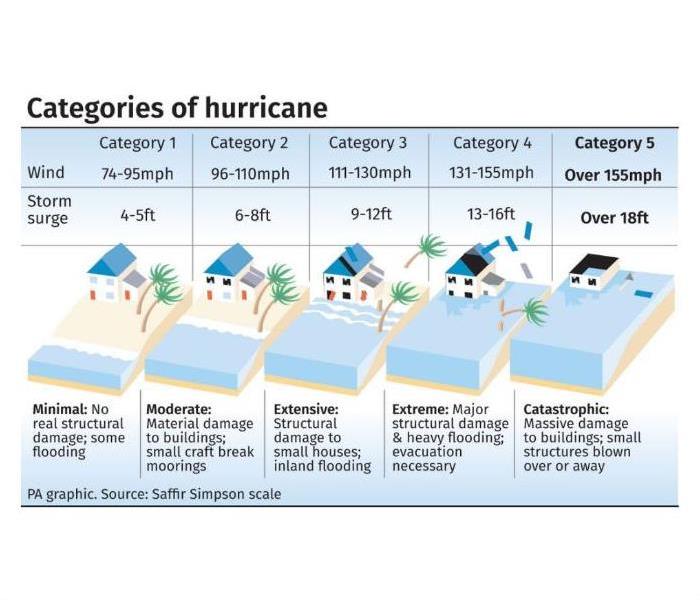 The Saffir-Simpson Scale is used to measure the size and effects of hurricanes on the Atlantic. The qualifying factors are illustrated above.
The Saffir-Simpson Scale is used to measure the size and effects of hurricanes on the Atlantic. The qualifying factors are illustrated above.
It should be no surprise that the 2020 Hurricane season is breaking records. According to Wikipedia, the 2020 Atlantic hurricane season is the first on record to tally nine tropical storms formed before August and thirteen before September. So far, a total of 14 tropical depressions, 13 tropical storms, four hurricanes and one major hurricane have developed. The latest, Laura, has just made landfall in LA as a Category 4 hurricane. This means it brings maximum sustained winds of 150 mph or greater and catastrophic storm surges.
Noel Torrissi, our Construction Manager, suggests covering storm and ocean facing windows as the first order of business. “Taping is always an option if boarding isn’t possible. Any way to create a barrier that can hold or stop flying glass should be your first concern. Incomplete, new construction is less of a concern as the materials are always exposed to the elements. Focus on safety first. We can rebuild any structure, but we can’t replace you.”
Secondly, if you have a generator, make sure it works before the storm barrels in. That means starting it up and gassing it up. You could be without power for hours, or days, depending on the severity of the storm. As always, generator safety is a priority. This means keeping it outside, even in a hurricane.
Water Pressure Check
6/8/2020 (Permalink)
With summer right around the corner, it’s time again to turn on outdoor water sources. As you begin to break out the sprinklers and garden hoses, keep an eye out for lowered water pressure. A loss in water pressure may be nothing, but it also could indicate there may be a bigger issue lurking just below the surface. One way you can test for low water pressure is to turn the spigot on and press your fingers against it. The water should spray out through your fingers at a good, steady level. If the water doesn’t spray out, or seems to be flowing at an inconsistent rate, this may be a sign and further investigation should be done to check for leaks. If you do find yourself with water damage, SERVPRO of Haverhill/Newburyport is here to help. Call us at 978-374-8555 to schedule an estimate.
Spring Weather Tips
3/24/2020 (Permalink)
While spring brings the promise of warm weather and longer days, it also brings a variety of conditions that can include heavy rains and severe weather, which can increase your flood risk. Take action to protect yourself, your family, and your business—before a weather event occurs and it’s too late.
April marks the start of the rainy season. Spring storms can bring several inches of rain in only a matter of hours or there can be consistent rainfall for days. These heavy rains can lead to severe flooding by over-saturating the ground, overfilling storm drains, or rivers spilling over their banks.
As one of the most common hazards in the United States, it’s important we prepare for the potential disaster that flooding can cause. Even if you feel you live in a community with a low risk of flooding, remember that anywhere it rains, it can flood. Just because you haven’t experienced a flood in the past, doesn’t mean you won’t in the future.
In order help prepare you for the possibility of a flood, we offer you these tips:
- Build an emergency kit and make a family communications plan
- Avoid building in a floodplain unless you elevate and reinforce your home
- Elevate the furnace, water heater and electric panel in your home if you live in an area that has a high flood risk
- Install check-valves to prevent flood water from backing up into the drains of your home
- Seal basement walls and floor with waterproofing compounds to prevent seepage through cracks
- Always keep your gutters and downspouts clean to allow water to flow freely
- Prepare a flood evacuation plan
- Know how to safely shut-off utilities
- Keep insurance and vital records in a water-proof box
- Have a portable radio to listen for important current information
When your home sustains water damage from flooding, you should call SERVPRO of Haverhill/Newburyport immediately.
SERVPRO of Haverhill/Newburyport has the equipment and experience necessary to handle the most challenging water damage and removal situations and we are available around-the-clock. Call us at (978) 374-8555, and we’ll return your home back to normal, "Like it never even happened."
What To Do In A Flood Emergency
3/11/2020 (Permalink)
With spring on its way, so is the rain, and house and/or business flooding is a real concern. Luckily, we can step in to help minimize the damage and get you back to normal living conditions, but there are some other important steps to take as well.
Stop The Flow
Your first priority is stopping the flow of water. If the flooding is due to storm surges, you should be seeking safe ground. Your possessions are replaceable. You aren't!
If you have time however, turn off electricity at the fuse box. If you can’t reach the box without wading into water, call an electrician and stay out of the wet areas. Most people don't think of this step during a flood but doing so can save a lot of extra repair once you're back in the house.
Snap It, Document It
Before removing any water, document the damage for your insurance company. Capture the extent of the water damage and all possessions impacted by the flood. Digital photos are best because you can quickly upload them directly to your agent for assessment.
Contact your insurance company as soon as possible and follow their directions. Not all flooding is covered by a basic homeowners policy, so work with your agent to discover the cause and identify coverage you can qualify for. Do not remove any water before talking to them so you don’t accidentally do anything that will decrease the amount of coverage you’ll be able to claim. If the insurance company wants you to wait for an adjuster before making repairs, do so — but make sure you give them a clear picture of the damage and repairs that are immediately needed.
Protect Yourself
You won’t know immediately if the water is contaminated, so take precautions to safeguard your health. Wear protective gear like waders or rubber boots and rubber gloves before delving into the water and removing water-logged possessions. If possible, remove children from the home until the damage is assessed and contained.
We're Here To Help
We are truly "faster to any disaster." When your home or business has water damage, we have the expertise and equipment to properly restore your property. The water removal and water cleanup process is completed by our highly-trained technicians who will document the drying process. This validates that your property has been dried properly and thoroughly.
Please follow the tips outlined in our Water Damage Tips—Until Help Arrives Guide to protect yourself and your property.
Water Damage Prevention Tips
2/13/2020 (Permalink)
Your home's foundation is the glue that holds your house together. Water damage is the number 1 culprit in weakening the foundation of your home. If water damage goes untreated, it can weaken the structure of your house, causing you a lot of money in the long run. Follow these prevention tips below to protect your home from water damage.
#1 - Endure Good Drainage
- Clean your gutters.
- Direct downspouts 5-10' away from the house.
- Slope your yard away from the foundation.
#2 -Test Your Sump Pump
- Check your sump pump once a year.
- Test more frequently during the rainy season.
#3 - Fix Water Leaks
- Repair any noticeable dripping pipes.
- Repair any cracked caulking.
- Inspect the roof for missing, loose or damaged shingles.
If you or anybody you know has water damage that needs assistance, don't hesitate to call SERVPRO of Haverhill/Newburyport. We are available, 24/7!
Secondary Water Damage
1/24/2020 (Permalink)
Coming home from a vacation and you realize the basement has 3 inches of standing water. What do you do? First, you need to assess the situation. If a pipe bursts, shut off the water and call your local SERVPRO. If a sump pump failed, call your plumber as soon as possible. A quick response is the key to mitigating, or minimizing, the loss in water damage.
If the cleanup process does not begin immediately and the water begins to evaporate on its own you can begin to suffer the effects of secondary damage, also known as moisture damage. The air will absorb the water and become fully saturated. As the evaporation continues the water can get into things like drywall and ceiling tiles. Here are some tips you can follow that might minimize the amount of damage your house will suffer after a water loss.
- Remove water from flat surfaces by mopping
- Open doors and drawers on furniture for ventilation and drying
- Remove electronics and artwork to a dry area
- Elevate all furniture
- Call SERVPRO of Haverhill/Newburyport for assistants. 978-374-8555
Avoid Burst Pipes & Ice Dams
1/17/2020 (Permalink)
Two of the biggest problems our customers encounter are frozen pipes and ice dams. A frozen pipe can burst causing considerable damage to your property if not addressed. Ice dams cause a back-flow under the roof’s shingles and can affect your structure’s interior areas. Below are some tips on how to prevent this damage and prepare your home for the winter weather.
Quick Easy Steps to Avoid Burst Pipes & Ice Dams:
- Keep cabinet doors open during cold spells
- Keep a slow trickle of water flowing through faucets
- Consider shutting off outdoor faucets
- Ensure gutters are clean and secure
- Inspect property for proper drainage to alleviate flood hazard potential
SERVPRO® of Haverhill/Newburyport is your local fire and water damage restoration company. Servicing the North Shore and Merrimack Valley for over 30 years, SERVPRO® understands the stress and worry that comes with a fire or water damage and the disruption it can cause your life, home or business. Our goal is to help minimize the interruption to your life and quickly make it “Like it never even happened.” ®
Clean Those Gutters
6/10/2019 (Permalink)
With the rainy season upon us, it is crucial that you keep your gutters clean. Gutters are the exterior protectors of your home. They collect rainwater from your roof and divert it away from the structure and landscaping of your home. But as the storms start to roll in, those gutters may need your assistance.
Do you live in a woodsy area with pine trees? Those pesky needles like to collect in your gutters causing them to clog. Clean those gutters out quarterly with a leaf blower, gutter scoop, or power washer to ensure good water flow.
Make sure to inspect your gutters after a heavy storm! Debris can pile up and decompose after a storm, which can lead to an ant or termite infestation. Heavy rain, wind, and hail can also crack the gutter. So make sure to check on those gutters after a storm.
A neglected clog in the gutter can cause water to pool in your basement. Clean the debris from your gutters immediately after a basement leak. If the damage is severe, you may have to call your local SERVPRO to help repair the damages.
If you do find yourself with water damage, SERVPRO of Haverhill/Newburyport is here to help. Call us at 978-374-8555 to schedule an estimate.
Prevent Water Damage this Spring
3/27/2019 (Permalink)
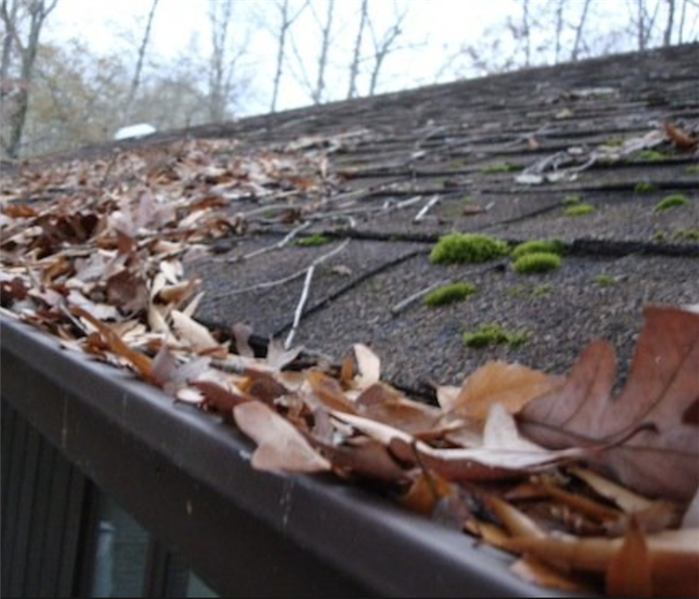 Clogged gutters can cause flooding through your roof or foundation.
Clogged gutters can cause flooding through your roof or foundation.
Springtime has arrived and now is a great time to take care of some outdoor maintenance of your home. You can prevent water damage in your home before it happens with a couple of simple tips.
Keep Your Gutters Clean
When leaves and debris clog your gutters, the water can’t drain out the downspouts and away from your property. This lack of drainage can cause the water to come back through the roof or the foundation, resulting in a flooded basement or water coming through your roof. Keeping your gutters clean is a simple way to prevent unwanted water from entering your home.
Outdoor Faucets
Sometimes outdoor faucet leaks are obvious- you will see the water dripping out. Other times, the leak isn’t visible from the outside. One way you can test for possible leaks is to turn the spigot on and press your fingers against it. The water should spray out through your fingers with good pressure. If the water pressure is low and doesn’t spray out, this maybe an indication of a leak and further investigation should be done to check for leaks.
If you do find yourself with water damage, SERVPRO of Haverhill/Newburyport is here to help. Call us at 978-374-8555 to schedule an estimate.
Spring Showers Can Cause Flooding in Haverhill
3/20/2019 (Permalink)
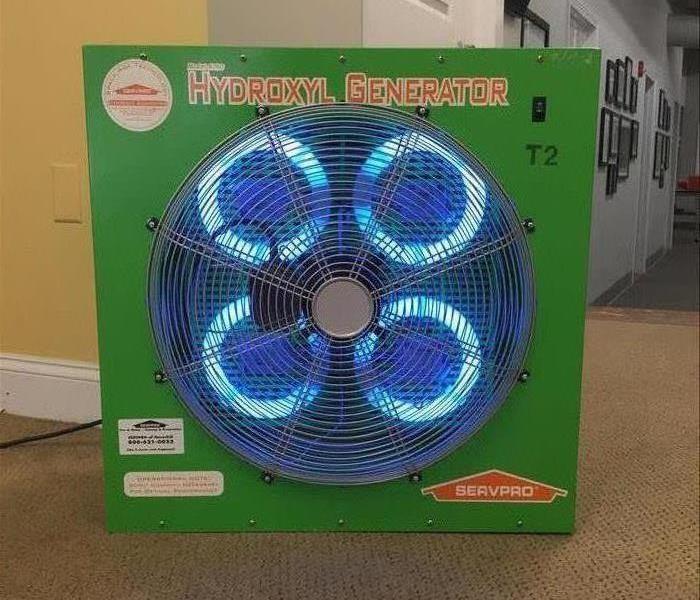 Photocatalytic Oxidizers remove unwanted odors and clean the air.
Photocatalytic Oxidizers remove unwanted odors and clean the air.
Springtime has finally arrived here in Haverhill, bringing longer days, rising temperatures, and yes, you guessed it...rain! April showers bring May flowers, but they also can bring flooding issues to your home or business. Spring storms can bring several inches of rain in only a matter of hours or there can be consistent rainfall for days. These heavy rains can lead to severe flooding by over-saturating the ground, overfilling storm drains, or rivers spilling over their banks.
Stagnant Water Odors
Untreated water damage from rain flooding can create a pungent, earthy, muddy smell. To prevent unwanted odors in your home or business, it’s best to be proactive and handle the water damage as soon as the flooding occurs. If the odor already exists, SERVPRO of Haverhill/Newburyport has specialized equipment to eliminate unwanted odors. Throughout the restoration and water removal process, we can remove odors and clean the air with our Photocatalytic Oxidizers. The oxidizers remove odors, kill germs, and safely clean the air. UV rays emitted from the Titan form electron hole pairs that react with water and oxygen in the air to oxidize and eliminate bad odors. If you find yourself with water damage from rain flooding, give us a call at 978-374-8555.
Groveland 24 Hour Emergency Water Damage Service
3/1/2019 (Permalink)
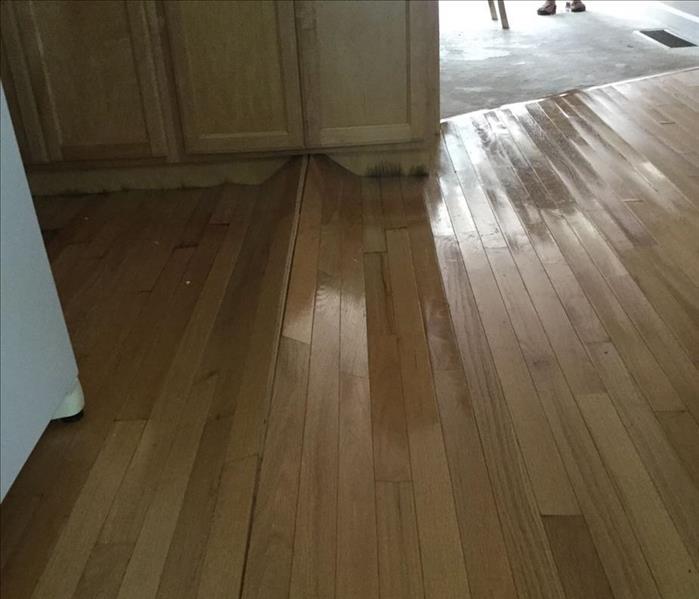 This image shows a hardwood floor that has bucked due to water damage.
This image shows a hardwood floor that has bucked due to water damage.
SERVPRO of Haverhill/Newburyport is available 24 hours a day for water emergencies, large or small. When you are dealing with water damage, immediate action is crucial. A delay of just a few hours can greatly increase the severity of the water damage.
We Answer the Phone Ready to Help
Call Today - 978-374-8555
We understand that when you call us, you may be feeling confused, stressed, and vulnerable. You need an expert to guide you through this crisis. SERVPRO of Haverhill/Newburyport has the specific water damage training and experience to help you through this tough time. We specialize in water damage restoration—in fact, it's the cornerstone of our business.
What to Expect
When you call, we will ask several questions regarding your water damage emergency. These questions will help us determine what equipment and resources to bring, including how many trained SERVPRO Professionals may be needed.
Our SERVPRO Representative will ask several questions:
- Your name and contact information
- Your insurance information (if applicable)
- The street address of the water-damaged home or business
- When did the flooding or water damage occur?
- What caused the water damage (if known)?
- Is there electricity available (on-site)?
About SERVPRO of Haverhill/Newburyport
SERVPRO of Haverhill/Newburyport specializes in the cleanup and restoration of residential and commercial property after a fire, smoke or water damage event. Our staff is highly trained in property damage restoration. From initial and ongoing training at SERVPRO’s corporate training facility to regular IICRC-industry certification, rest assured our staff is equipped with the knowledge to restore your property.
Newburyport Residents: We Specialize in Flooded Basement Cleanup and Restoration!
2/13/2019 (Permalink)
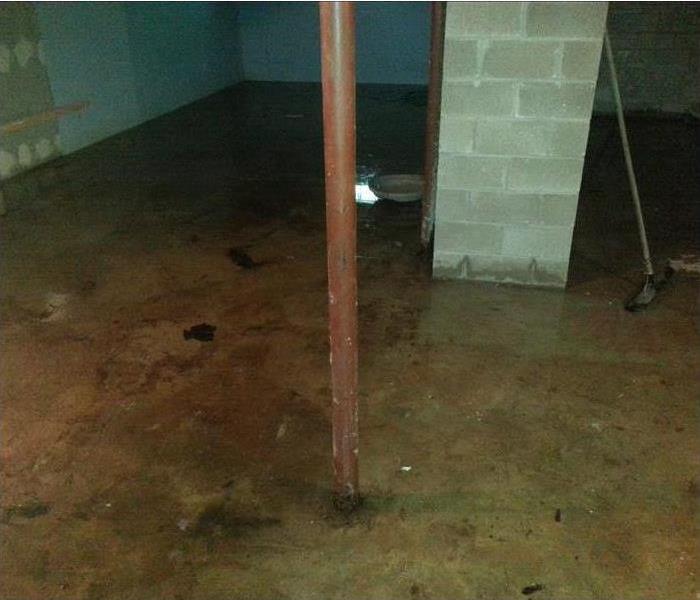 This Newburyport homes's basement flooded due to heavy rains.
This Newburyport homes's basement flooded due to heavy rains.
A basement can flood at any time, although flooding most often occurs during heavy rainfall. Basements are inherently prone to flooding because they are the lowest level of a building and are normally built partly or entirely below ground level. There are a number of reasons why your Newburyport basement could flood, including:
- A blocked or failed sewer lateral pipe
- Heavy rain causes surface water to pool around your home
- Storm sewer backup
- Sanitary sewer backup
- Foundation drainage failure
- Water supply-line break or hot-water tank failure
- And many more
Have Questions about Basement Flooding?
Call Today – SERVPRO of Haverhill/Newburyport
If flood water is not handled quickly and properly, it can jeopardize your health and safety, and cause severe damage to your home’s structure. Remember, the longer you wait, the worse the problem will get.
The bottom line: a flooded basement can jeopardize your health, safety, and your home’s integrity. It’s worth making a call to SERVPRO of Haverhll/Newburyport and let our trained, professional crews handle the situation safely and correctly. We have earned the trust of hundreds of homeowners, business owners, and property professionals.
We are Flooded Basement Specialists:
- We are Available 24 hours/7 days per week
- We’re a Preferred Vendor to many National Insurance Companies
- We Bill The Insurance Directly – One Less Thing For You To Worry About
- Our Technicians are Highly-Trained in Water Restoration Techniques
- We use s500 IICRC Restoration Standards
- Advanced Inspection and Extraction Equipment
Basement Flooded? Call Us Today – We’re Ready To Help
978-374-8555
Got Water Damage in your Haverhill Home? We Can Help.
2/8/2019 (Permalink)
 Give us a call if you find yourself with a household flood.
Give us a call if you find yourself with a household flood.
Flooding and water emergencies don’t wait for regular business hours and neither does SERVPRO of Haverhill/Newburyport. We provide emergency cleaning and restoration services 24 hours a day, 7 days a week—including all holidays.
Flooding and water damage is very invasive. Water spreads quickly throughout your home and can absorb into the floors, walls, and furniture. Our crews arrives quickly and start the water extraction process almost immediately.
This immediate response helps to minimize the damage and the cleaning and restoration costs. The water damage timeline below details the damage that occurs if no action is taken.
Within Minutes
- Water quickly spreads throughout your property, saturating everything in its path.
- Water is absorbed into walls, floors, upholstery, and belongings.
- Furniture finishes may bleed, causing permanent staining on carpets.
- Photographs, books, and other paper goods start to swell and warp.
First 24 Hours
- Drywall begins to swell and break down.
- Metal surfaces begin to tarnish.
- Furniture begins to swell and crack.
- Dyes and inks from cloth and paper goods spread and stain.
- A musty odor appears.
48 Hours to One Week
- Mold and mildew may grow and spread.
- Doors, windows, and studs swell and warp.
- Metal begins to rust and corrode.
- Furniture warps and shows signs of mold.
- Paint begins to blister.
- Wood flooring swells and warps.
- Serious biohazard contamination is possible.
More Than One Week
- Restoration time and cost increase dramatically; replacing contaminated materials and structural rebuilding may be extensive.
- Structural safety, mold growth, and biohazard contaminants pose serious risks to occupants.
As leaders in the water damage industry, we have advanced training and expertise, and a tremendous amount of hands-on experience. If you need water restoration services, give us a call. We make it "Like it never even happened."
Call us today at 978-374-8555!
Project Estimators Best TIps
6/25/2018 (Permalink)
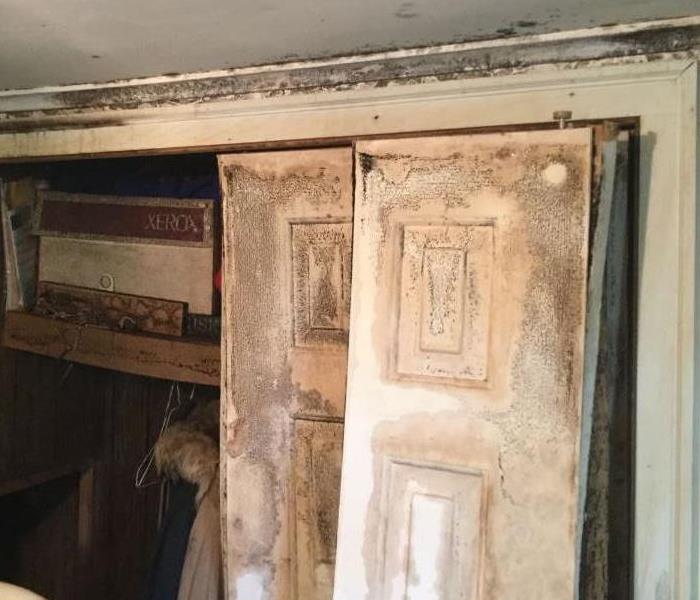 This is an example of mold damage that occurred after the homeowner suffered water damage on the floor level.
This is an example of mold damage that occurred after the homeowner suffered water damage on the floor level.
Summer brings lots of outside activities and happy memories, lazy days at the beach and nights by the campfire. But it can also bring severe storms. Although these can move out as swiftly as they move in, we often experience heavy rains that the ground simply cannot absorb quickly enough. When that happens, water will find the downward path of least resistance, which can often be your basement.
We asked our Project Estimators, Brian Carifio and Ross Martin, what their best advice was to homeowners after heavy rainstorms. Here are their top tips:
- What’s the first thing you would advise a homeowner to check after a storm?
Brian Carifio: The Basement. Water will find its way there. Ideally, if they’ve been pre-emptive, they’ll have their contents up off of the floor on plastic shelving and/or in plastic containers. Keeping contents 2–4 inches off the floor will help to avoid most flooding concerns. If the water reaches above that, they have a whole other set of problems. Plus, content damage is not generally covered by insurance when due to flash flooding.
- Okay, they’ve done that but they still have water in the basement. What should they do next?
Brian Carifio: Call SERVPRO. Not to sound self-serving but the longer the homeowner waits…or tries to mitigate it themselves, the greater the probability of mold beginning to grow. Most DIY attempts at mitigating water damage fail simply because the necessary equipment is not available to consumers. You need strong extraction systems, high capacity dehumidifiers, and air movers (not to be confused with oscillating fans).
- What’s the worst thing a homeowner can do when they find water in their basement?
Ross Martin: Put an oscillating fan on the standing water. First of all, you can run the risk of electrocution. Beyond that, fans only whisk the air off the top of the water’s surface and move it into the air. Doing that without proper dehumidification in place can lead to mold on other surfaces.
- Can you explain that process more?
Ross Martin: Sure. When you have a flood, if left alone the water will eventually evaporate. But that doesn’t mean it disappears. It simply changes from a liquid to a gas and moves into the air. Moisture in the air is relative humidity. That humid (moisture heavy) air is then able to touch & attach to every single surface in that space and beyond. This is the “perfect storm” for mold growth.
Our process is to first extract the water with truck mounted vacuums, then use our air movers and dehumidifiers simultaneously. The movers circulate the air, keeping it from absorbing into surfaces while the dehumidifiers remove the moisture from the air.
- Can’t homeowners do this themselves?
Ross Martin: Yes and no. There are several points to consider. First, consider the weight of water (not the movie!). A gallon of water weighs 8.34 lbs and most shop vacs hold 10 gallons. That means you’re carrying 83.4 pounds upstairs, multiple times.
Secondly, most people have fans in their home and will put several on the affected wet areas, thinking this will dry it out. It won’t. Fans are not strong enough and they don’t actually dry anything. They just move the moisture off the top surface, dispersing it throughout the air.
And lastly, most consumer-bought dehumidifiers are too small to effectively dry the air in an average sized basement. Most are purchased rated at 30 PPD (Pints Per Day). That’s how many pints of moisture it can handle per day. Our smallest is 70 PPD and goes up to over 133 PPD.
There are some steps you can take before help arrives though.
- Remove excess water by mopping and blotting.
- Wipe excess water from wood furniture after removal of lamps and tabletop items.
- Remove and prop wet upholstery and cushions.
- Place aluminum foil or wood blocks between furniture legs and wet carpeting.
- Turn air conditioning on for maximum drying in summer.
- Remove colored rugs from wet carpeting.
- Remove art objects to a safe, dry place.
- Gather loose items from floors.
Sewage Cleanup is a Biohazard
4/10/2018 (Permalink)
Sewage Cleanup and Restoration
Water from sewer system backups should be considered very dangerous. The water is grossly unsanitary and may contain bacteria and viruses that could cause serious illness. Special training and equipment are necessary to safely clean this type of contamination.
When a sewage backup happens, you need to move quickly. Evacuate young children, elderly, people with asthma and weak immune systems first. Then call a plumber to remedy the problem.
Sometimes you can manage small sewage spills without professional help. Small spills are typically confined to a bathroom or part of a kitchen. Major spills, however, require professional help. Sewage is a natural delivery method for disease and infection.
Sewage Backup or Toilet Overflow? Call Us Today – (978) 374-8555
There are three major types of contaminated water. SERVPRO of Haverhill/Newburyport will inspect that contaminated water to determine the type of water and then plan the appropriate response to safely restore your home or business.
Frosty's Not The Only One At Risk!
3/26/2018 (Permalink)

Protecting Your Home from Melting Snow
When temperatures begin to rise after a long winter, it can certainly be reason to celebrate. But if you've got significant snow accumulation on, or around, your home it can also be cause for concern. And not just for Frosty! Here are some tips to help prevent damage to your home as snow starts melting.
- Remove snow from around your home: snow accumulation near your foundation, windows, and doors can leak into your home once it starts to melt. Remember to shovel any decks, driveways or patios that slope towards your home.
- Check your roof and gutters: consider hiring a professional to remove the snow from your roof so that water run-off is at a minimum once temperatures rise. If that's not possible, be sure that your gutters are clear so that the water will have a path away from your home. If possible, attach a sloped leader to your downspout that leads run-off at least 10ft from your home.
- Test your sump pump: if water does get into your basement, you want to be sure it is taken care of quickly. Before the snow starts to melt, test your sump pump and your sump pump discharge pipe to ensure it's in working order.
- Clear snow from drainage areas: storm drains and catch basins can often get clogged with snow — if you can do so safely, clearing snow from these areas can help keep water away from your home.
- Rearrange your storage: in case water does get into your basement, be sure to keep any valuables, chemicals, or anything else you'd like to keep dry off the floor.
- Check your appliances: clear out space around your water heater, furnace and other appliances. If possible, raising your washer and dryer off the floor could help protect from water damage.
- Don't try to do too much: getting on ladders or your roof at any time of the year is a risky proposition, even more so when there is snow involved. Clearing snow and gutters is important in the prevention of water damage, but be sure to use a professional to handle any dangerous situations.
If you do suffer water damage as a result of melting snow, call us. We're here to help!
Sensing Unseen Water Damage
3/7/2018 (Permalink)
Even small water damages have the potential to cause serious structural and indoor air quality issues over time.
The key to avoiding costly future restoration is to handle every water problem as a real threat to your property. SERVPRO of Haverhill/Newburyport has the equipment, training and experience to find and dry unseen water before secondary damages occur. The proper equipment makes a measurable difference in reducing the damage expense during a fire or water loss. When time matters, technology and equipment must be counted on to perform. SERVPRO® of Haverhill/Newburyport will answer your call with fast action and a full arsenal of drying equipment. Here are a few of the tools used:
- Moisture Sensors are used to detect moisture in carpets, baseboards and Moisture Meters (pictured) are used to determine the actual moisture content of various materials. The moisture tester provides accurate readings, allowing SERVPRO® Franchise Professionals to monitor the drying process.
- Thermohygrometers measure temperature and relative humidity. When armed with this information, SERVPRO® of Haverhill/Newburyport can calculate and create an environment most conclusive to drying.
- When facing a contaminated water loss, it is not only important to dry the structure, but the structure must also be disinfected and often deodorized.
- Ultra-Low-Volume (ULV) Foggers will atomize liquid deodorizing agents, producing a fine mist that can easily penetrate the site where odor-causing residues may accumulate. This device can also be used to inject fungicides and disinfectants into wall cavities and other hard-to-reach
- Thermal Foggers (pictured) dispense solvent-based produces by creating a dense fog. The fog consists of tiny particles of deodorant solution that attach to and neutralize odor causing particles.
What is the bottom line? SERVPRO® of Haverhill/Newburyport has the training and equipment to help make it "Like it never even happened."
What To Do If Your House Floods
3/2/2018 (Permalink)
With the crazy weather we've been experiencing lately, house and/or business flooding is a real concern. Luckily, we can step in to help minimize the damage and get your back to normal living conditions, but there are some other important steps to take as well.
Stop The Flow
Your first priority is stopping the flow of water. If the flooding is due to storm surges, you should be seeking safe ground. Your possessions are replaceable. You aren't!
If you have time however, turn off electricity at the fuse box. If you can’t reach the box without wading into water, call an electrician and stay out of the wet areas. Most people don't think of this step during a flood but doing so can save a lot of extra repair once you're back in the house.
Snap It, Document It
Before removing any water, document the damage for your insurance company. Capture the extent of the water damage and all possessions impacted by the flood. Digital photos are best because you can quickly upload them directly to your agent for assessment.
Contact your insurance company as soon as possible and follow their directions. Not all flooding is covered by a basic homeowners policy, so work with your agent to discover the cause and identify coverage you can qualify for. Do not remove any water before talking to them so you don’t accidentally do anything that will decrease the amount of coverage you’ll be able to claim. If the insurance company wants you to wait for an adjuster before making repairs, do so — but make sure you give them a clear picture of the damage and repairs that are immediately needed.
Protect Yourself
You won’t know immediately if the water is contaminated, so take precautions to safeguard your health. Wear protective gear like waders or rubber boots and rubber gloves before delving into the water and removing water-logged possessions. If possible, remove children from the home until the damage is assessed and contained.
We're Here To Help
We are truly "faster to any disaster." When your home or business has water damage, we have the expertise and equipment to properly restore your property. The water removal and water cleanup process is completed by our highly-trained technicians who will document the drying process. This validates that your property has been dried properly and thoroughly.
Please follow the tips outlined in our Water Damage Tips—Until Help Arrives Guide to protect yourself and your property.
Winter Weather Tips
2/13/2018 (Permalink)
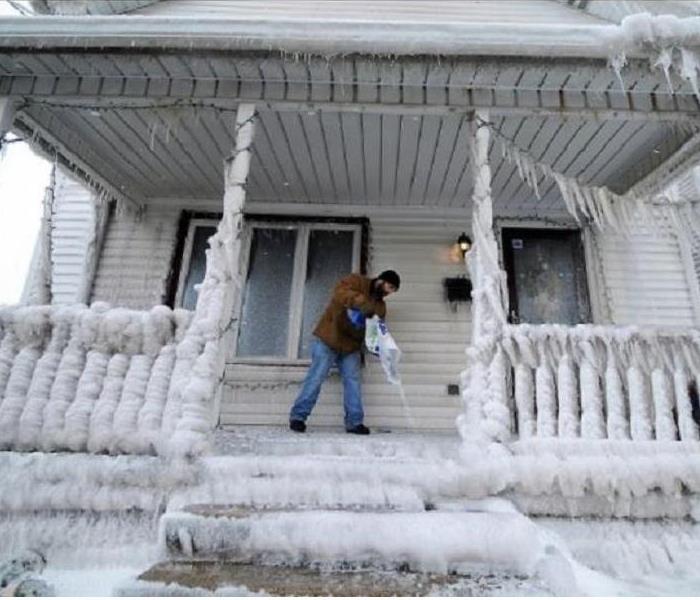 A man puts ice melt on the stairs of his winter-beaten home.
A man puts ice melt on the stairs of his winter-beaten home.
Punxsutawney Phil saw his shadow and the national weather reporting agencies are predicting cold temps reaching into April, even early May possibly. Don't shoot the messenger!
With that said, two of the biggest problems our customers encounter are frozen pipes and ice dams. A frozen pipe can burst causing considerable damage to your property if not addressed. Ice dams cause a back-flow under the roof’s shingles and can affect your structure’s interior areas. Below are some tips on how to prevent this damage and prepare your home for the winter weather.
Quick Easy Steps to Avoid Burst Pipes & Ice Dams:
- Keep cabinet doors open during cold spells
- Keep a slow trickle of water flowing through faucets
- Consider shutting off outdoor faucets
- Ensure gutters are clean and secure
- Inspect property for proper drainage to alleviate flood hazard potential
SERVPRO® of Haverhill/Newburyport is your local fire and water damage restoration company. Servicing the North Shore and Merrimack Valley for over 30 years, SERVPRO® understands the stress and worry that comes with a fire or water damage and the disruption it can cause your life, home or business. Our goal is to help minimize the interruption to your life and quickly make it “Like it never even happened.”®
Flooded School in West Newbury, MA
1/10/2018 (Permalink)
Is Your Business Prepared For A Crisis?
Instead of ringing in 2018 with toasts of prosperity and good health, many business found themselves focused on damage control as record low temperatures hit Massachusetts, causing pipes and sprinkler systems to freeze and burst. Such was the case at a beloved, local elementary school in the overnight hours of a very cold January night when a pipe ruptured in a first floor bathroom sending 30,000 gallons of water rushing, unrestrained, through hallways, classrooms, and ceilings of the Page School in West Newbury, MA.
When a catastrophe such as this occurs, it’s the level of preparedness, training, proper equipment and a plan of action that can make the difference between an inconvenience and a total loss for your business.
Because Page School had the foresight to work with SERVPRO to complete an ERP (Emergency Readiness Plan), the maintenance team and first responders were able to quickly locate the shut-off valves, stemming the continued flow of water and therefore, minimizing the loss and environmental risk.
An ERP is a simple preparedness program that is completed at no charge to the customer. It provides a digital blueprint of key information such as location of utility shut-offs, property details, building access, and important contacts that may otherwise be floating in a paper file or on a computer hard drive inaccessible to you. A true game changer during any crisis, right on your phone…in a simple, free app.
When our SERVPRO of Haverhill/Newburyport franchise received the call at 1:00 a.m., we were onsite within 30 minutes. The project was assessed, an emergency team was assembled, and mitigation began within 2 hours. No time was wasted in containing necessary areas, extracting water, dehumidifying and drying, disinfecting and removing saturated drywall.
The key to remediation is time…the quicker you start extracting and drying, the less time the water has to saturate and permeate surfaces. Removing drywall above the water line is paramount as mold can start to grow in as little as 3 days. When not correctly managed, it can grow silently, unbeknownst to you, within the drywall as it did at Page School, causing even more problems when it’s eventually discovered.
Disinfecting all areas, from ceiling to floor is also a concern as water can carry bacteria, dirt, and debris, depositing it in areas where you eat, work and play.
The SERVPRO emergency crew worked in shifts until the entire school was cleaned and moisture readings were back to an acceptable level. Although crews still remain there to remediate the mold, the original crisis is a memory.
In a press release issued to the media on January 3, Superintendent Mulqueen sites the timely response of West Newbury’s emergency responders, the District’s facilities team, and SERVPRO as the main factors in minimizing damage to the school. Had mold not been discovered, the school would have been operational in a matter of days.
The moral of this story is preparedness as well as working with trained professionals who make it their job to remain focused and productive during a crisis. You may never need to engage such a system but when & if you do, having a trained response team ready to go will get your life back to working order faster and with less stress.
SERVPRO mitigates thousands of losses each year. If you are interested in ensuring your business is prepared for the unexpected, call us to learn more about our Emergency Readiness Program (ERP) at 978-374-8555 or 978-356-7077.
SERVPRO of Haverhill/Newburyport - Fast Water Damage Response
4/13/2017 (Permalink)
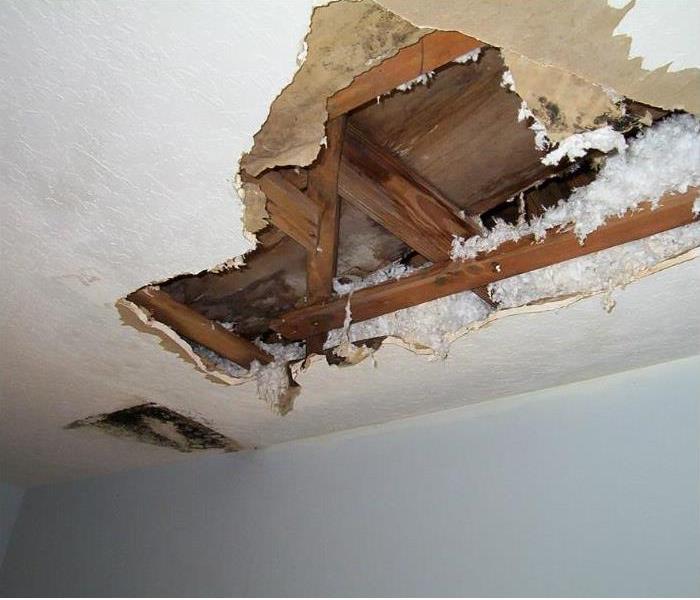 Flooding and water damage is very invasive. Water quickly spreads throughout your home and gets absorbed into floors, walls, furniture, and more.
Flooding and water damage is very invasive. Water quickly spreads throughout your home and gets absorbed into floors, walls, furniture, and more.
Flooding and water emergencies don’t wait for regular business hours and neither does SERVPRO of Haverhill/Newburyport. We provide emergency cleaning and restoration services 24 hours a day, 7 days a week—including all holidays.
Flooding and water damage is very invasive. Water quickly spreads throughout your home and gets absorbed into floors, walls, furniture, and more. SERVPRO of Haverhill/Newburyport arrives quickly and starts the water extraction process almost immediately.
This immediate response helps to minimize the damage and the cleaning and restoration costs. The water damage timeline below details the damage that occurs if no action is taken.
Within Minutes
- Water quickly spreads throughout your property, saturating everything in its path.
- Water is absorbed into walls, floors, upholstery, and belongings.
- Furniture finishes may bleed, causing permanent staining on carpets.
- Photographs, books, and other paper goods start to swell and warp.
First 24 Hours
- Drywall begins to swell and break down.
- Metal surfaces begin to tarnish.
- Furniture begins to swell and crack.
- Dyes and inks from cloth and paper goods spread and stain.
- A musty odor appears.
48 Hours to One Week
- Mold and mildew may grow and spread.
- Doors, windows, and studs swell and warp.
- Metal begins to rust and corrode.
- Furniture warps and shows signs of mold.
- Paint begins to blister.
- Wood flooring swells and warps.
- Serious biohazard contamination is possible.
More Than One Week
- Restoration time and cost increase dramatically; replacing contaminated materials and structural rebuilding may be extensive.
- Structural safety, mold growth, and biohazard contaminants pose serious risks to occupants.
As leaders in the water damage industry, we have advanced training and expertise, not to mention a tremendous amount of hands-on experience. We use this training and experience to quickly dry your home and restore it back to pre-water-damage condition. Our process includes documentation of the drying process to validate your property is dry.
Call us today at 978-374-8555 for more information.
Severe Spring Weather Tips
3/24/2017 (Permalink)
While spring brings the promise of warm weather and longer days, it also brings a variety of conditions that can include heavy rains and severe weather, which can increase your flood risk. Take action to protect yourself, your family, and your business—before a weather event occurs and it’s too late.
April marks the start of the rainy season. Spring storms can bring several inches of rain in only a matter of hours or there can be consistent rainfall for days. These heavy rains can lead to severe flooding by over-saturating the ground, overfilling storm drains, or rivers spilling over their banks.
As one of the most common hazards in the United States, it’s important we prepare for the potential disaster that flooding can cause. Even if you feel you live in a community with a low risk of flooding, remember that anywhere it rains, it can flood. Just because you haven’t experienced a flood in the past, doesn’t mean you won’t in the future.
In order help prepare you for the possibility of a flood, we offer you these tips:
- Build an emergency kit and make a family communications plan
- Avoid building in a floodplain unless you elevate and reinforce your home
- Elevate the furnace, water heater and electric panel in your home if you live in an area that has a high flood risk
- Install check-valves to prevent flood water from backing up into the drains of your home
- Seal basement walls and floor with waterproofing compounds to prevent seepage through cracks
- Always keep your gutters and downspouts clean to allow water to flow freely
- Prepare a flood evacuation plan
- Know how to safely shut-off utilities
- Keep insurance and vital records in a water-proof box
- Have a portable radio to listen for important current information
When your home sustains water damage from flooding, you should call SERVPRO of Haverhill/Newburyport immediately. SERVPRO of Haverhill/Newburyport professionals have the expertise to prevent or mitigate the devastating effects that water damage can have.
SERVPRO of Haverhill/Newburyport has the equipment and experience necessary to handle the most challenging water damage and removal situations and we are available around-the-clock. Call us at (978) 374-8555, and we’ll return your home back to normal, "Like it never even happened."
Winter Weather Tips
12/13/2016 (Permalink)
SERVPRO® of Haverhill/Newburyport is your local fire and water damage restoration company. Servicing the North Shore and Merrimack Valley for over 30 years, SERVPRO® understands the stress and worry that comes with a fire or water damage and the disruption it can cause your life, home or business. Our goal is to help minimize the interruption to your life and quickly make it “Like it never even happened.”®
With the cold weather upon us, two of the biggest problems our customers encounter are frozen pipes and ice dams. A frozen pipe can burst causing considerable damage to your property if not addressed. Ice dams cause a backflow under the roof’s shingles and can affect your structure’s interior areas. Below are some tips on how to prevent this damage and prepare your home for the winter weather.
- Keep cabinet doors open during cold spells
- Keep a slow trickle of water flowing through faucets
- Consider shutting off outdoor faucets
- Ensure gutters are clean and secure
- Inspect property for proper drainage to alleviate flood hazard potential






 24/7 Emergency Service
24/7 Emergency Service


















